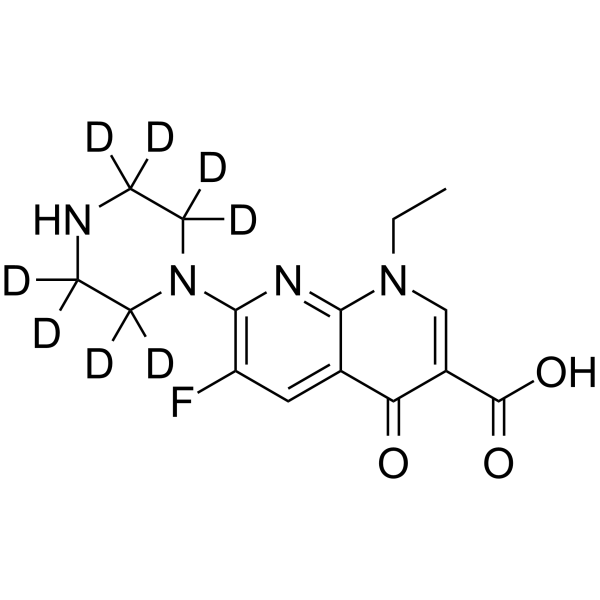上海金畔生物科技有限公司为生命科学和医药研发人员提供生物活性分子抑制剂、激动剂、特异性抑制剂、化合物库、重组蛋白,专注于信号通路和疾病研究领域。
Enoxacin-d8
Enoxacin-d8 是 Enoxacin 的氘代物。Enoxacin (AT 2266) 是一种氟喹诺酮,可以干扰 DNA 复制,抑制细菌 DNA 促旋酶 (IC50=126 µg/ml) 和拓扑异构酶 IV (IC50=26.5 µg/ml)。Enoxacin 是一种 miRNA 加工激活剂,可增强 siRNA 介导的 mRNA 降解并促进内源性 miRNA 的生物发生,也可增强 TAR RNA 结合蛋白 2 (TRBP) 介导的 microRNA 加工。Enoxacin 有效抑制革兰氏阳性和阴性细菌, 是一种特异性的癌症生长抑制剂。

Enoxacin-d8 Chemical Structure
CAS No. : 1329642-60-5
| 规格 | 是否有货 | ||
|---|---|---|---|
| 2.5 mg | Check price and availability | ||
| 25 mg | Check price and availability | ||
* Please select Quantity before adding items.
| 生物活性 |
Enoxacin-d8 (AT 2266-d8) is the deuterium labeled Enoxacin. Enoxacin (AT 2266), a fluoroquinolone, interferes with DNA replication and inhibits bacterial DNA gyrase (IC50=126 µg/ml) and topoisomerase IV (IC50=26.5 µg/ml). Enoxacin is a miRNA processing activator and enhances siRNA-mediated mRNA degradation and promotes the biogenesis of endogenous miRNAs. Enoxacin has potent activities against gram-positive and -negative bacteria. Enoxacin is a cancer-specific growth inhibitor that acts by enhancing TAR RNA-binding protein 2 (TRBP)-mediated microRNA processing[1][2][3][4]. |
|---|---|
| 体外研究 (In Vitro) |
Stable heavy isotopes of hydrogen, carbon, and other elements have been incorporated into drug molecules, largely as tracers for quantitation during the drug development process. Deuteration has gained attention because of its potential to affect the pharmacokinetic and metabolic profiles of drugs[1]. 上海金畔生物科技有限公司 has not independently confirmed the accuracy of these methods. They are for reference only. |
| 分子量 |
328.37 |
| Formula |
C15H9D8FN4O3 |
| CAS 号 |
1329642-60-5 |
| 运输条件 |
Room temperature in continental US; may vary elsewhere. |
| 储存方式 |
Please store the product under the recommended conditions in the Certificate of Analysis. |
| 参考文献 |
|
所有产品仅用作科学研究或药证申报,我们不为任何个人用途提供产品和服务
